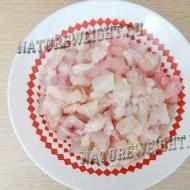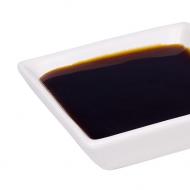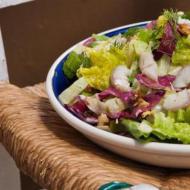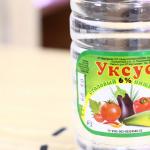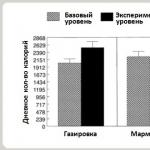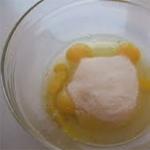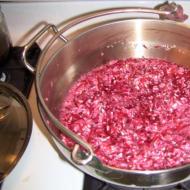
How many carbohydrates are in an orange. Orange calories, useful properties
Bright, juicy, sunny fruits - oranges - a favorite delicacy of adults and children. These citrus fruits, originally from China, are loved by people all over the world for their rich aroma and sour-sweet taste. They are not only tasty, but also healthy, and low calorie content and the ability to increase the metabolism in the body allows you to use oranges to lose weight and keep your figure in good shape. These fruits are part of many diets, fasting days are based on them. They are good as a snack, and the juice squeezed out of them is a source of energy for the whole day.
The benefits of oranges for weight loss
Juicy orange citrus is a real pantry of health: it contains many substances necessary for the human body. The main value of an orange is its high content of vitamin C, which is not synthesized in the body, but is extremely important for maintaining health and well-being, because this vitamin:
- regulates the metabolism of proteins, fats and carbohydrates;
- participates in the process of collagen synthesis, which ensures the elasticity and firmness of skin cells and blood vessels;
- stimulates the immune system;
- promotes the removal of free radicals and salts of heavy metals from the body;
- strengthens bone tissue.
Orange is a real storehouse of vitamin C. In addition to the benefits of orange for the body, this fruit is also incredibly tasty.
Many mistakenly believe that the leader among citrus fruits in terms of vitamin C content is lemon (40 mg of vitamin C per 100 g). But it's not. In an orange, ascorbic acid is one and a half times more than in a lemon: 60 mg. Grapefruit (55 mg) is slightly inferior to him in this. Just one fruit supplies the body with 80 mg of ascorbic acid, which is the daily norm for an adult. In addition, oranges contain:
- vitamins A, B1, B2, B6, B9, E, H and PP necessary for a person, participating in vital processes;
- potassium, calcium, zinc, magnesium, phosphorus and sodium - minerals that regulate the activity of all body systems;
- pectins that normalize metabolism;
- fiber that improves bowel function;
- phytoncides, due to which oranges have antibacterial properties;
- bioflavonoids, in particular, hesperidin, which lowers blood cholesterol and blood pressure.
Most of the nutrients are concentrated in the zest and in the white partitions of the fruit, and not just in the pulp. Fresh fruit retains all the beneficial properties, but during heat treatment they are lost. Therefore, orange jam, although it is very tasty, does not bring any benefit to the body, and its calorie content is much higher than the calorie content of fresh oranges.
How many calories are in oranges?
The calorie content of oranges, depending on the variety, is about 40 kcal per 100 g. Sweeter varieties contain more carbohydrates, which is why they are more nutritious.

One orange weighing 130 grams provides the human body with a daily intake of vitamin C.
How many carbs are in an orange? The fruit is 85% water, 2.2% dietary fiber, 1% protein and contains almost no fat - only 0.2%. Carbohydrates, which are presented in the form of fructose and glucose, account for 8.1%.
The ratio of proteins, fats and carbohydrates (bzhu) in oranges: 10/5/90. This means that the fruit contains too many carbohydrates with a low content of proteins and fats. Despite the fact that the calories contained in an orange are quickly burned, due to the excess carbohydrates, people who monitor their weight and diabetics should not eat them in kilograms or drink liters of orange juice. The optimal amount is two medium oranges per day or one large. In this amount, nutritionists recommend eating oranges when losing weight.
How many calories are in 1 orange?

Oranges are primarily a major source of vitamin C and bioflavonoids.
Orange peel is a source of nutrients and fiber, but not all people are used to eating this sunny fruit completely. Due to the bitter taste, the upper part of the fruit is usually not eaten. Based on this, 1 orange without peel contains approximately 50 kcal.
Orange juice and fresh juice: benefits and calories
Fresh - freshly squeezed orange juice - a refreshing, tasty and healthy drink. Just one glass of juice satisfies the body's daily need for vitamin C. Its regular intake compensates for the lack of many vitamins, minerals, and increases susceptibility to infectious diseases.
The calorie content of freshly squeezed orange juice depends on the degree of pomace and is about 40 kcal / 100 g. The calorie content of store-bought packaged orange juice is higher than that of freshly squeezed (45–55 kcal), since sugar is often added to it. A glass of orange fresh (250 g) contains 28 g of carbohydrates, its calorie content is 100 kcal, and packaged juice already contains 34 g of sugar with an energy value of 135 kcal.
These indicators for store-bought juice from a package vary depending on the recipe adopted at the plant where it is produced.
To whom the use of juicy fruits is contraindicated
Despite the value of oranges and freshly squeezed juices from it, they are not recommended for people with exacerbations of gastritis, with high acidity of gastric juice and with peptic ulcer of the stomach and duodenum.
You can not use these fruits and people with allergies to citrus fruits, patients with diabetes. With caution, pregnant and lactating mothers should eat oranges in small doses.
Is it possible to eat oranges while losing weight
Orange citrus fruits are often included in the diet menu. There are several varieties of orange diets. This is due not only to the fact that oranges contain few calories, but also to its low glycemic index. It is 35 units, which means that this fruit gives a feeling of satiety for a long time after eating it. It owes this property to the high content of fiber and pectins - dietary fibers that contribute to:
- improving digestion;
- decrease in appetite and calorie content of food;
- stimulation of metabolism;
- removal of toxins from the body.
The useful vitamins and minerals that are part of the orange fruit have a beneficial effect on the redox processes in the body and increase metabolism.
Studies by Italian scientists have shown that red Sicilian oranges are best suited for weight loss. Only they contain a special substance, thanks to which the regular use of this variety of fruits prevents weight gain and burns existing fat deposits. Oranges are best eaten fresh with pulp. In the summer, you can make a refreshing orange smoothie with ice using a blender, or treat yourself to a fruit salad with orange slices.
Thus, including this sunny fruit in your daily diet, you can avoid many health problems, improve your well-being and appearance, and lose weight.
How many calories in an orange, depends on the size of the fruit and its ripeness. A riper orange contains more sugar and therefore a higher calorie content.
Average, 100 g of orange contains 40 kcal. An average orange weighs about 150 grams, so its calorie content is about 60-70 kcal.
Undoubtedly, low calorie orange makes it one of the dietary products. Moreover, the high content of vitamins in an orange brings additional benefits to the body.

ORANGE not only tasty, but also useful. They contain phytoncides, a large amount of vitamins necessary for the human body. Oranges are used in cooking, in medicine, and you can also make candles and various crafts from them.
Everyone's calculations are different.
One of the most beautiful, juicy and healthy citrus fruits. Yes, it does contain calories. Of course, the calorie content of one orange depends on its size. Well, on average it is 60 calories.
Oranges are different, both in shape and in taste. Of course, the calorie content in one orange, depending on its type, is different. The sweeter and tastier the orange pulp, the more calories it contains.
The average calorie content of orange pulp in 100 gr. - 47 kcal. If we take into account that one orange weighs an average of 150 grams, then the calorie content of one orange will be 70 kcal.
An orange and an apple have almost the same number of calories, with the exception of green apples.
There are about 65 calories in one orange, and the sweeter the orange, the more calories it contains, but not by much - only 5 - 10.
But in orange juice there are slightly less calories than in the fruit itself by 5-10 Kcal.
An orange has an average of 44 calories, but depending on the variety, its calorie content can reach 57 calories. An orange is 80% water, but nevertheless it is good because the body spends more calories on its digestion than the calories contained in it.
Oranges are low-calorie foods, in terms of calories and amount of vitamin C, they are very close to strawberries. Oranges contain approximately 35-43 calories per 100 grams, strawberries - 32-35 calories per 100 grams. Thus, this citrus fruit is relatively low in calories.

Oranges are one of the lowest calorie fruits due to the abundance of water in their composition. Their calorie content is approximately at the level of the calorie content of apples - according to various sources, from 43 to 47 calories per 100 grams. Therefore, oranges are often used in various diets, for example, based on orange juice or fresh juice - their calorie content is even lower and is approximately 36 calories per hundred grams of juice. Now about the calorie content of one orange. It is believed that the average orange weighs about 120 grams, but nowhere is it mentioned that the net is the weight of the edible product or the weight with the peel is taken into account. I conducted my experiment, since there were oranges in the refrigerator - their weight ranged from 110 to 132 grams, having cleaned the largest orange, I got a net weight of 104 grams. That is, it turned out that one medium orange in its pure form should weigh about one hundred grams and its calorie content will be rounded to 50 calories.
Orange a truly valuable fruit that is rich in vitamin C, which helps prevent colds and various diseases (sailors stored oranges in their holds, as this protected them from a terrible disease - scurvy), and it is also practically waste-free: the pulp is eaten, and the zest is used in cooking to add flavor and flavor to various dishes.
Since orange fruits vary in weight, it will be difficult to accurately determine the calorie content of one orange. But 100 grams of an orange contains about 43 calories. And one orange weighs from 120 to 200 grams, so the calorie content of one orange will vary from 52 to 86 calories.

100 grams of orange contains about 40 calories.
If we take an orange of medium size (and it weighs somewhere in the region of 180-200 grams) and calculate its calorie content, we will get about 70-80 calories in 1 piece.
Oranges are a wonderful dietary product. They are rich in vitamins, especially vitamin C. And this is very important, especially in winter and spring, when the body is weakened and especially susceptible to diseases.
Oranges, like all citrus fruits, are high in fiber. And as you know, fiber improves intestinal motility, promotes better digestion of food, binds fats and promotes weight loss. It is thanks to these properties that oranges have found application in many diets: the orange diet, the orange diet for a week, the orange three-day fasting diet, and as part of other diets.
In addition, oranges have long been used to treat and prevent a wide variety of diseases:
Oranges are used for
prevention of scurvy.
How many calories are in one orange?
One medium orange weighs about 120 grams and contains the daily requirement of vitamin C for an adult. At the same time, the calorie content of one medium orange is only 50 calories. The calorie content of larger fruits is not much higher. So an orange with a diameter of 7.5 cm contains only 65 calories.
What are the benefits of oranges?
Vitamins are well preserved in this orange fruit, even when stored for a long time.
Oranges are rich in folic acid, which helps with infertility. Vitamin C is indicated for viral diseases, strengthens the immune system. It cleanses the blood, strengthens the vessels of the heart, prevents the formation of atherosclerotic plaques, lowers blood pressure and has a slight diuretic effect.
Oranges contain antioxidants that slow down aging, and thanks to their fiber and pectin content, they improve digestion.
Therefore, be sure to include at least one orange per day in your diet.
But if used incorrectly, they can be hazardous to your health.
Why are oranges dangerous?
All citrus fruits that enter our market, including oranges, must be processed with chemicals. The most dangerous for our health is methyl bromide or matilbromide. This substance is actively used in agriculture to protect fruits from pests. It helps the fruit to more easily endure transportation. But how deeply it penetrates through the skin of an orange and how long no one really knows. Meanwhile, it is a neurotropic highly toxic poison.
In many European countries, they are forbidden to process fruits, but not in our country.
In addition, diphenyl / biphenyl / is very dangerous. It is an antiseptic that prevents the development of fungal diseases, bacterial infections, molds. All citrus fruits are also actively processed with it for better preservation during long-term transportation. It can accumulate in the human body and is a carcinogen. Its toxic effect on the heart, kidneys, liver and nervous system was also noted. Especially harmful to children. Banned in many countries. In Russia it is allowed for use.
What is the right way to consume oranges?
Therefore, before eating oranges, they must be washed with hot water and preferably with soap. After peeling oranges, it is also recommended to wash your hands. Do not give unpeeled oranges to children.
Choose to eat oranges that have retained their natural flavor. Do not use orange peel for cooking recipes.
Remember that poison, even in small doses, is poison and it is best to reduce the consumption of this beautiful fruit in your menu.
Orange calorie and nutritional table
| The product's name | Number of grams of the product | Contains |
| orange | 100g | 43 kcal |
| one orange with a diameter of 6.5 cm | 100g | 43 kcal |
| one orange with a diameter of 7.5 cm | 150 grams | 64.5 kcal |
| proteins | 100g | 0.9 gr. |
| fat | 100g | 0.2 gr. |
| carbohydrates | 100g | 8.1 gr. |
| dietary fiber | 100g | 2.2 gr. |
| water | 100g | 86.8 gr. |
100 grams of orange contains the following trace elements:
Magnesium 13 mg; Sodium 13 mg; Potassium 197 mg; Phosphorus 23 mg; Chlorine 3 mg; Sulfur 9 mg; Iron 0.3 mg; Zinc 0.2 mg;
Iodine 2 mcg; Copper 67 mcg; Manganese 0.03 mg; Fluorine 17 mcg; Boron 180 mcg; Cobalt 1 mg
100 grams of oranges contain the following vitamins:
Vitamin PP 0.2 mg
Beta-carotene 0.05 mg
Vitamin A 8 mcg
Vitamin B1 (thiamine) 0.04 mg
Vitamin B2 (riboflavin) 0.03 mg
Vitamin B5 (pantothenic) 0.3 mg
Vitamin B6 (pyridoxine) 0.06 mg
Vitamin B9 (folic) 5 mcg
Vitamin C 60 mg
Vitamin E (TE) 0.2 mg
Vitamin H (biotin) 1 mcg
Everyone knows that an orange contains a huge amount of vitamin C, which stimulates the immune system and promotes the synthesis of collagen, which is necessary to maintain the elasticity of various tissues of the human body. At the same time, the low calorie content of the orange has made it one of the most popular foods in the world.
How many calories in an orange and calories in orange juice
The calorie content of an orange is about 47 kcal per 100 g, while it contains 0.9 g of protein, 0.2 g of fat and 8.1 g of carbohydrates. Orange is rich in flavonoids, which, together with vitamin C, have a complex anti-cancer effect. In addition, the orange is rich in dietary fiber, which lowers blood cholesterol levels.
Surprisingly, the maximum amount of valuable substances is found in the orange peel and those white partitions that form the slices. Orange pulp also contains vitamins A, B1, B2, PP, iron, potassium, calcium, magnesium, sodium and phosphorus. The calorie content of orange juice is 55 kcal per 100 g of drink.
Oranges have a beneficial effect on the digestive, nervous, cardiovascular and endocrine systems. Their use promotes the speedy healing of abscesses and other wounds, is characterized by a tonic, tonic, anti-inflammatory and antimicrobial effect, improves metabolism. Oranges also have the ability to lower blood pressure and reduce swelling.
Taking into account the calorie content, oranges are recommended in the diet of patients with diabetes mellitus, with various vitamin deficiencies, loss of strength and general fatigue. They stimulate appetite and perfectly quench thirst, especially with hyperthermia. The delicious taste and low calorie content of an orange make it an ideal dessert.
Calorie content of 1 orange. Oranges for weight loss
The calorie content of 1 orange does not exceed 100 kcal. Oranges for weight loss are an ideal product due to their availability, nutritional value and low calorie content. Orange contributes to the appearance of a long-lasting feeling of fullness, which is an important component in the fight against extra pounds, due to the high content of fiber in its pulp.
 The calorie content of a red orange is at the same level, while it is the red varieties of oranges for weight loss that are most preferable, since they most effectively prevent the deposition of fat. In order to diversify the diet menu, you should include fresh oranges in various salads and other dishes.
The calorie content of a red orange is at the same level, while it is the red varieties of oranges for weight loss that are most preferable, since they most effectively prevent the deposition of fat. In order to diversify the diet menu, you should include fresh oranges in various salads and other dishes.
The beauty of the orange diet is that it requires you to limit yourself to food for five days of the week, and on weekends you can eat as usual. A similar regimen is observed for three weeks, while the expected weight loss is about ten kilograms.
The orange diet does not regulate breakfasts, lunches and dinners, but offers a specific list of foods that are recommended to be eaten during the day. So, during the first week, one kilogram of an orange and two hard-boiled eggs are consumed daily; drink at least 2 liters of still water. In the second week, the eggs are replaced with porridge (preferably buckwheat and cooked without salt), and in the third - with fresh and boiled vegetables.
Orange weight loss is effective, healthy and tasty. It is quite easily tolerated despite the fact that there are few calories in an orange, and is available at any time of the year. A contraindication for the use of any orange is the presence of an allergic reaction or individual intolerance.
Easily accelerate metabolism and affect skin quality. Organic acids, which are part of oranges and tangerines, suppress hunger and accelerate satiety. The calorie content of an orange is 43 kcal per 100 grams.
The leaves of citrus trees are also eaten. Orange peel smells good and can be used as a flavoring agent.
The aroma of citrus tree symbolizes freshness and purity, combined with the tastes of "green tea", "bergamot", "sea breeze", "lavender". Orange is interpreted as a sweet bitterness, a subtle but very noticeable aroma. It is not recommended to mix it with very similar flavors, such as or. Perfumes based on this fruit are distinctly individual.
Orange fruit or berry? This question is best answered by scientists. According to official data, an orange is both at the same time. On the one hand, it is considered a multi-celled berry, and on the other, a large and juicy fruit.
Do you know what bergamot is? In tea and perfumery, the taste and smell of the same name is used everywhere. In fact, bergamot is an extract of the aforementioned orange tree, once brought to Europe from Arab countries. Roughly reminiscent of the sweetness of an orange, but more restrained and tart, bergamot delights us during evening teas and when we use cosmetics.
In ancient times, oranges were brought from China, considering the juicy fruit a delicacy and a valuable delicacy. A rare item received as a gift depicted an offer to marry, or to conclude a valuable deal. Another variety of the plant, the "orange tree", is still of value in medicine and homeopathy. Tasteless, bitter small fruits were used as the basis for medicines and poisons. Today the tree has a decorative purpose.
Where oranges grow
In the USA, in the states of California and Florida, where oranges grow, the cultivation of orange fruits is considered a national business. In America, the orange delicacy is exported to other countries. The import comes from Brazil and Mexico. The culture is widespread in India and China, Iran and Pakistan, Turkey. Far fewer resources are spent on orange production in Europe, with small shipments shipped in from Spain and Greece.
Varieties of oranges
There are the following types of oranges:
- Gamlin. It is a rounded juicy fruit with an orange peel. Large quantities are imported from Brazil as well as the USA. This variety is characterized by high resistance to transportation, storage and harsh temperature conditions.
- Verne. It has a slightly oblique (elongated) shape, with an extremely tasty filling of fruit pulp. It grows in the European part of the continent, it is easily saturated with solar heat and useful substances.
- Salustian. Often found in our stores under the name "pitted orange". Morocco is considered the birthplace of the fruit, the variety is well cultivated in Spain. This subtype ripens late in plantations and has a sweet-sour, often neutral taste.
- Navel (Late, Washington, etc.) - a group of plants that bear very large fruits. They have a characteristic difference - the navel, often young oranges are smooth on them, do not have characteristic protrusions. They earned fame thanks to their large (up to 600 g) sizes.
- The navel, which distinguishes the Navel group of varieties, is similar to that of a lemon. This feature became the trademark of American farmers and spread throughout the world. Enthusiastic fans of the heavy fruits are attacking stores to try new, modified varieties and varieties.
How to choose the right orange
How much an orange weighs depends on the variety, and the importing country, different sizes of the product are excellent examples of one or another type. It is worth focusing on values from 100-150 to 300 g. Larger specimens have a higher calorie content, contain water, as well as harmful, irritating acids, so you should pay attention to moderately developed fruits.
When shopping during the orange season, there is a chance to choose a very tasty and healthy purchase with a low calorie content. Individual consignments from abroad are delivered for almost a whole year, and are in no way inferior to the quality of summer or winter deliveries. From November to March - the harvest of orange delicacies in Europe and America, September-October and April-March - the time of the year when the southern countries take up the harvest of fruits and berries.
orange peel
Rarely, but used for gastronomic purposes. The peel is included in ground form in teas, compotes and tinctures. It is an excellent weight stabilizer and antioxidant. In 100 grams of the peel, the calorie content is about 16 kcal. The low nutritional value of the product makes the orange a low-calorie food and a dietary product at the same time.
Steaming orange peel is often recommended as a weight loss drink. Citric acid or a small amount of berry vinegar is great to quench your thirst if you make a solution of the skin and vinegar (acid) in water. The calorie content of the drink does not exceed 100-150 kcal. Orange peel is used in the preparation of sweets or jellies.
Candied fruits are boiled fruits mixed with sugar or honey. Since they are very sweet, with a sour taste, but only whet the appetite, sugar fruits are eaten in chocolate or glaze. The calorie content of the finished dessert dish is very high, reaching 500-1000 kcal.
Chemical composition
You can find out how many carbohydrates are in an orange in this section. The ratio of BJU of an orange (proteins, fats, carbohydrates) for a citrus fruit is quite high: with a low calorie content of carbohydrates, it is 8.1 g per 100 g of product; 0.2 g fats and 0.9 g proteins; the rest of the weight is compensated by water and acids.
Complex carbohydrates are better absorbed by the body due to the “ascorbic acid”. It is used not only by itself, in the form of tablets, but also with iron preparations, for better absorption. Studies of the treatment of scurvy and winter vitamin deficiency show that the active carbohydrates that exist in the fruits of plants are able to produce a “shake-up” in a person, to awaken previously hidden immune resources.
vitamins
What vitamins are in orange? The most important useful element is vitamin C. Due to the high content of ascorbic acid in a ripened fruit, the body's daily need for the "vitamin of the sun" is covered with a low-calorie meal.
In addition, the composition of the fruit includes B1 / B2, A, PP, magnesium, sodium, calcium, phosphorus, iron and potassium.
A similar group of vitamins can be traced in any yellow, orange and red fruits. Vitamins B1 and B2, which act as catalysts for the creation of blood bodies and cells, also have a positive effect on the walls of blood vessels, capillaries, and even vision.
Magnesium improves the functioning of the nervous system, largely because of it and because of ascorbic acid, we feel happiness when we eat oranges. Sedentary children who are busy with their studies are encouraged to eat a few slices of orange before lunch and dinner to cheer up and be ready for further training.
The calcium-sodium combination refers us to the building of bones, and the accumulation of mineral reserves. Overeating foods with salt ions and significant calorie content is not worth it - this will lead to increased urination, a feeling of thirst, and drowsiness. Small doses of these trace elements are beneficial for the musculoskeletal system and water-salt metabolism.
orange calories
The calorie content of an orange is 43 kcal. Low nutritional value does not affect the feeling of fullness in the body. A light fruit satisfies not only hunger, but also thirst, it is used as part of many dishes, both dietary and very satisfying (high in calories). A chocolate-covered orange is popular as a dessert, or a whole fruit for lunch.
Makes the product attractive for people who watch their weight and shape.
Useful qualities of an orange
To the question "orange useful properties - do they exist?" doctors and experts answer. Recent studies by Western scientists have confirmed that orange pulp perfectly prevents early aging, has a tonic effect on the nervous system and skin, and normalizes the work of the heart. Low calorie. Reduced calorie content brings irreplaceable benefits in the treatment of beriberi, which destroys the entire body system, dysbacteriosis, insufficient acidity of the pH of the stomach, scurvy and immune diseases. Improves metabolism in liver diseases, if you eat at least half of the fetus during the day (calorie content of a serving is from 43 to 70 kcal).
Essential oil of zest or citrus - is considered not only a cosmetic product. Antioxidant oils, substances that prolong life and youth, give the skin not even health, but a magical glow.
Do you know how orange is useful for the human body?
Let's make a list of useful properties of a citrus fruit.
For women
Orange juice will prevent the harmful processes of aging at an early age. Vitamin C in the composition of ascorbic acid is perfectly absorbed in this product; it protects against blindness, irritation, eczema and wrinkles. Calorie content is almost leveled.
For men
Together with the peel, they are recommended for diseases of the gastrointestinal tract, for constipation and irritation of peristalsis. They perfectly increase immunity and do not allow blood sugar or cholesterol to “stagnate”. Citrus products have a reduced calorie content, which prevents the formation of fat deposits on the back and abdomen.
For children
A source of joy and energy, reliably helps the body in the cold season. Natural sweets strengthen the immune system, the fruit is very useful during stress and exams. A few fruits will replace a snack at school. Orange juice is easily digested for viral and colds.
Citrus fruits are recommended for everyone when it comes to nutritional and preventive procedures. Diets based on vitamin C are aimed at normalizing metabolism, active physical education and sports.
The action of the sweet and sour menu is effective, which is noticeable after a week of the diet. Natural orange helps to cope with stretch marks, cellulite. The reduced calorie content of the product makes it a competitor to other dietary crops.
Orange juice
Natural juice, or fresh (fresh) without additional ingredients, has a number of useful properties, low calorie content, perfectly relieves thirst and unpleasant aftertaste of alcoholic beverages.
In company with other sour and sweet juices, it creates a rich combination of flavors. It goes well with cranberries (calorie content up to 50-60), cherries, sweet cherries and gooseberries; with relatives - (calorie content up to 70-100), lemon and blends perfectly into one compound drink.

About 300-400 ml. natural juice can delay the feeling of hunger for 1.5-2 hours. Adding sugar as a simple carbohydrate will help tone your body and mind. Sweetened store-bought juices cannot always boast of useful elements preserved after conservation and good calorie content. It is advised to give preference to fresh pomace, not to add cheap or very bright dyes.
Fresh goes well with all types of dishes: fish and lean meat. Freshly squeezed juice is the best choice for a range of alcoholic and alcoholic beverages. The combination of low-calorie citrus pomace with sweets and desserts is appropriate in ice cream and fruit cake.
Harm of an orange
The harm of oranges is most often associated with individual intolerance to substances by the body. Yet this is not a native European fruit, but something very exotic, so even with the high prevalence of oranges, we find it difficult to digest it.
Dermatitis or skin irritation often occurs, and the acid affects the human heart system. In this case, it is better to postpone the drink or food. During the holidays, drinking alcohol reduces immunity, increases the calorie content of the food eaten. Glucose allergy is much more common.
Contraindications for use
Among the factors that prevent the use of oranges for food are:
- Too much sugar in the blood.
- Increased acidity of the stomach.
- High calorie menu.
- Gastritis and ulcerative colitis of varying degrees.
- Allergy to other citrus fruits, intolerance to vitamin C and other components.
- It is not recommended to use orange and antibiotics at the same time.


